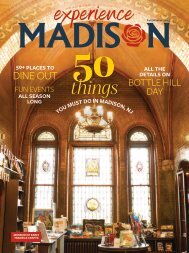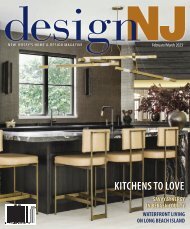Create successful ePaper yourself
Turn your PDF publications into a flip-book with our unique Google optimized e-Paper software.
PHOTOGRAPH: ERIK RANK
yx
eat & drink
eat &
drink
EDITED BY ERIC LEVIN
Settling for Survival
Amid huge losses, restaurants adapt to takeout and
brace for a chastened new normal. by Eric Levin
“it’s a madhouse every minute of the
day,” said Al Santillo, pushing another
pizza into his century-old brick oven.
“I’m 63, and my buddies say, ‘retire
and come play cards,’ but I feel needed
here.” The oven, 16 feet deep, is in the
tiny house in Elizabeth where Santillo,
the son of a baker, grew up. Since the
pandemic began, he’s been putting in 15-
hour days and has committed to donating
seven pies a day to the local hospital
and EMS squad “for the duration.”
“I’ve been here 30 years,” he said,
“and I’ve never been this busy.”
With the restriction of restaurants to
takeout and delivery in response to Covid-19,
pizza—inexpensive, transportable
and beloved—may be one of the few
relative bright spots, at least for places
like Santillo’s that were already takeout
dynamos. “Pizzerias,” said Domenico
Boccia, a salesman for Ferraro Foods in
Piscataway and one of Santillo’s suppliers,
“are surviving the best of anybody.”
But if pizza is a bright spot, it bobs in
WRAP
AND RUN
Meny Vaknin, chef/
owner of Mishmish in
Montclair, completes a
take-out order and places
it with others for pick up.
“I’ve got no time for
anything else,” he
says.
a sea of darkness. As of early May, when
this issue went to press, “97 percent of
restaurant operators in the state have
laid off or furloughed employees,” said
Marilou Halvorsen, executive director
of the New Jersey Restaurant and
Hospitality Association. This amounts
to about 222,000 people out of work in
a restaurant and hospitality labor force
that was about 350,000 strong, she said.
The National Restaurant Association
estimates there are 19,050 eating and
drinking places in the state.
For owners, the decision to close temporarily
or soldier on was not easy. Shutting
down meant not only loss of income,
but giving away or throwing out precious
inventory while continuing to shoulder
fixed costs such as rent, taxes, utilities.
Staying open made sense only if the
menu could be readily adapted to takeout—impractical
for fine dining exemplars
like Restaurant Nicholas in Red
Bank or the Ryland Inn in Whitehouse
Station. But restaurants run on passion.
For many operators, staying open, or
reopening after a brief closure—even
with reduced staff, a reduced menu and
reduced prices—was a bet worth making.
“If we had kept closed,” said Meny
Vaknin, whose flagship, Mishmish, is
one of three restaurants he owns in
Montclair, the risk of losing customers
as well as valued staff would have
increased, making it “harder to come
back.” To boost revenue, a number of
places, including South + Pine in Morristown,
Viaggio in Wayne, and all Turning
Point locations, began grocery items.
To ease the pain, Congress created
the Paycheck Protection Program to
make small-business loans that
would be forgiven if at least 75
percent of were applied to payroll.
But the fine print imposed
conditions that, for restaurants,
were seen as hobbling. Chief
among these was the requirement
to spend all the money
within eight weeks, a span in which
normal operations were impossible.
Still, several respected New Jersey
restaurateurs took the loans, including
Vaknin, Dan Richer of Razza in Jersey
City, and Neilly Robinson of Heirloom
Kitchen in Old Bridge. “It’s given us the
confidence to operate with a full staff,”
Robinson said. “It’s nothing to scoff at.”
On April 22, the National Restaurant
Association released a pamphlet,
Covid-19 Reopening Guidelines, that
confirmed a lot of speculation. In addition
to heightened standards for sanitizing
surfaces and employee hygiene, it
recommended spacing tables at least six
feet apart and placing partitions between
them. Suggestions included, “Consider a
reservations-only business model, ...try
not to allow guests to congregate in waiting
areas or bar areas, ...[and] discontinue
self-serve buffets and salad bars.”
These restrictions will mean perhaps
a 50 percent reduction in seating
capacity and therefore revenue. It’s
questionable whether small restaurants
can survive under those terms. Whether
people will flock to take those seats
also remains to be seen. At some point,
restaurants will again be allowed to seat
people at tables. Whether people will
readily take those seats and accept close
proximity to others, even with partitions
and such, remains to be seen.
JUNE 2020 NEW JERSEY MONTHLY 63

















